Tallinn seems to have it all.To my mind it is the most attractive of the three Baltic capitals: it is also the one which looks(historic old town apart) most like a western European city.The central business district ,which begins where the old town ends, is full of modern glass fronted office buildings,and, although I think there are still some Soviet-era suburbs, they were not in evidence.
All three of the Baltic capitals are very different, and each have their attractions and interesting points: really, all should be seen as they all have different things to offer.
The other advantage for Tallinn’s position in my attractiveness stakes is that it’s directly on the sea, and has a busy port a few hundred metres from the Old Town. Historically, the trading this has allowed has made it successful: now this continues ,although some would say that it is also its downfall, because there are up to 6 cruise ships moored at any one time, and tourists swamp the Old Town. This must be good if you have a tourist-dependent business but unpleasant if you are a lone tourist. There were four of the things in the harbour when I arrived at 10am,and I would judge that the crowds were as busy as in Venice.The streets are wider,which improves the flow just a bit but in some streets it was impossible to get by as one tour group,each following its flag bearing leader ,passed another.
All three of the Baltic capitals are very different, and each have their attractions and interesting points: really, all should be seen as they all have different things to offer.
The other advantage for Tallinn’s position in my attractiveness stakes is that it’s directly on the sea, and has a busy port a few hundred metres from the Old Town. Historically, the trading this has allowed has made it successful: now this continues ,although some would say that it is also its downfall, because there are up to 6 cruise ships moored at any one time, and tourists swamp the Old Town. This must be good if you have a tourist-dependent business but unpleasant if you are a lone tourist. There were four of the things in the harbour when I arrived at 10am,and I would judge that the crowds were as busy as in Venice.The streets are wider,which improves the flow just a bit but in some streets it was impossible to get by as one tour group,each following its flag bearing leader ,passed another.
In terms of the historic points of interest,again,Tallinn pretty much has it all.It has a walled old town,with pointy roofs on the towers.Above the lower Old Town ,is the upper Old Town (Toompea),a separate citadel which has always been the base of the ruler at any given time, and where the Estonian parliament building is situated today.The Lower town apparently just got on with the business of trade and getting wealthy and was an important part of the Hanseatic league which controlled trade in Northern Europe roughly from the 13th to the 17th centuries.Pictures show quite a lot of damage to the old town during WW2 but it has all been restored now.There is an eclectic mixture of medieval merchants’ houses and Guild headquarters ,and some Baroque buildings mixed in, and now,having got my eye in while in Riga,I could spot even the occasional Art Nouveau building too.
I visited the town museum housed in a 14th century merchant's house: here there was depicted the interesting historical background regarding Tallinn’s emergence as an important trading city in the Hanseatic league,but ,like all museums in the Baltics, it also dwelt heavily on the Soviet takeover in 1940 ,the German invasion,and then the subsequent Soviet occupation lasting until independence in 1991.There was another “Museum of the Occupation” elsewhere in the town but I think I have got the idea by now and gave that one a miss.What I should have like to have visited was the KGB rooms in the Viru hotel.During the Soviet era this was the only hotel that foreigners were allowed to stay at ;It has had a thorough makeover and is a state of the art modern hotel now,but they have preserved as a museum the control centre which the KGB used to eavesdrop on all the rooms. Unfortunately this turned out to be a popular attraction and you need to book.
I visited the town museum housed in a 14th century merchant's house: here there was depicted the interesting historical background regarding Tallinn’s emergence as an important trading city in the Hanseatic league,but ,like all museums in the Baltics, it also dwelt heavily on the Soviet takeover in 1940 ,the German invasion,and then the subsequent Soviet occupation lasting until independence in 1991.There was another “Museum of the Occupation” elsewhere in the town but I think I have got the idea by now and gave that one a miss.What I should have like to have visited was the KGB rooms in the Viru hotel.During the Soviet era this was the only hotel that foreigners were allowed to stay at ;It has had a thorough makeover and is a state of the art modern hotel now,but they have preserved as a museum the control centre which the KGB used to eavesdrop on all the rooms. Unfortunately this turned out to be a popular attraction and you need to book.
By midday I found the crowds getting really unpleasant so I walked to the harbour front where there is a maritime Museum in an old seaplane hanger.It is a modern interactive museum where you can create tsunamis,fly seaplanes, redesign hulls and propellers etc,not really 'my type': however ,its centrepiece is the WW2 submarine “Lembit”,built in Barrow -in-Furness in 1936,one of two state-of-the art submarines Britain sold to Estonia, then an independent nation.It fell into Russian hands in 1940 and after an undistinguished career in the Russian navy, became a training boat.The information said that during the early days of the cold war it was considered useful to train on British equipment ,although of pre-war vintage. You can go aboard the sub and clamber through the compartments.
There was also the story of the Polish submarine Orzel,which ,after Germany invaded Poland,had put into the then neutral port of Tallinn.She was interned by the Estonian authorities but escaped,and managed to get to England(and continued the war from there);However ,The Russians accused the Estonians of aiding a belligerent power(even though Russia was not at war with Poland officially ,and claimed it had sunk a Russian ship.They used this as one of their pretexts for violating Estonian neutrality and taking over the country in 1939,before fully invading in 1940.
There were some historic boats moored at the quay too,which you can go aboard.This includes several near-obsolete minesweepers given to Estonia by the Germans in 1995 soon after independence and taken out of service 6 years later when,presumably,more up to date versions were available.Also there was the steam powered ice-breaker Suur Toll.Built in 1914,this was considered so necessary to keep the local sea lanes open in the winter that it only finished service in the Soviet navy in the 70’s.
I discovered some quiet little neighbourhoods between the Old Town and the docks, of historic wooden houses, I think dating from the 19th century.
There was also the story of the Polish submarine Orzel,which ,after Germany invaded Poland,had put into the then neutral port of Tallinn.She was interned by the Estonian authorities but escaped,and managed to get to England(and continued the war from there);However ,The Russians accused the Estonians of aiding a belligerent power(even though Russia was not at war with Poland officially ,and claimed it had sunk a Russian ship.They used this as one of their pretexts for violating Estonian neutrality and taking over the country in 1939,before fully invading in 1940.
There were some historic boats moored at the quay too,which you can go aboard.This includes several near-obsolete minesweepers given to Estonia by the Germans in 1995 soon after independence and taken out of service 6 years later when,presumably,more up to date versions were available.Also there was the steam powered ice-breaker Suur Toll.Built in 1914,this was considered so necessary to keep the local sea lanes open in the winter that it only finished service in the Soviet navy in the 70’s.
I discovered some quiet little neighbourhoods between the Old Town and the docks, of historic wooden houses, I think dating from the 19th century.
| |
Returning to the old town at 3pm I found it much quieter: presumably the cruise tourists were mostly back in their ships. I visited St Nicholas’ church,a medieval building partially destroyed in WW2.It has been restored and is now a medieval religious art museum,and occasionally a concert hall.The star attraction here is the 15th century painting of a Danse Macabre,by Bernt Notke.Although only 10 metres of the original 30 metres survive,it is still interesting, showing a series of important and wealthy stereotypical people of the age,but every alternative figure is a dancing skeleton ,the message being death gets everyone,no matter your status.
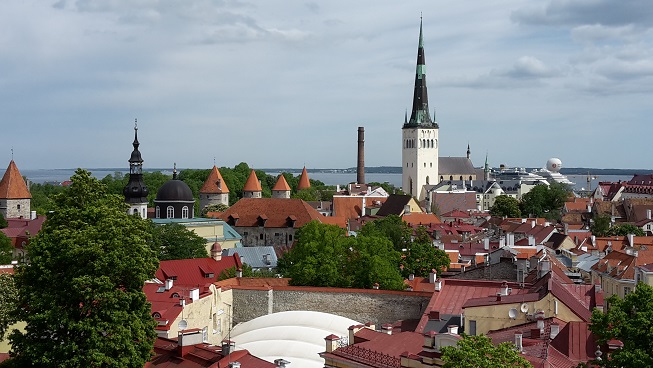
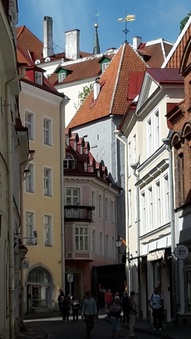
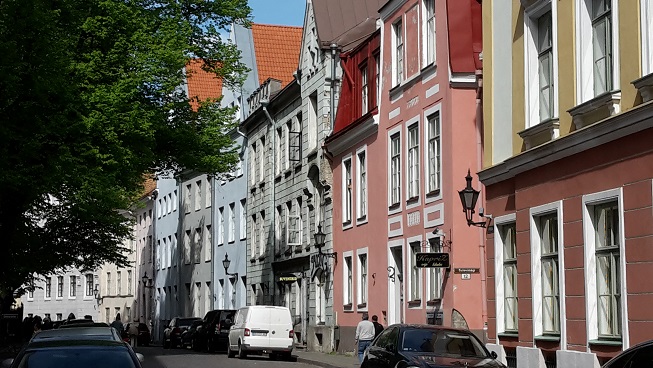
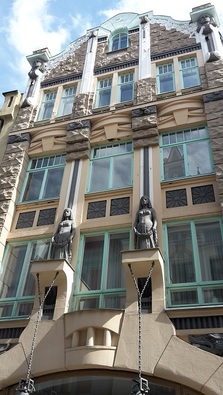
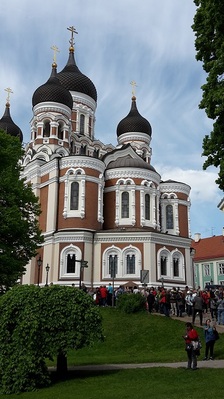
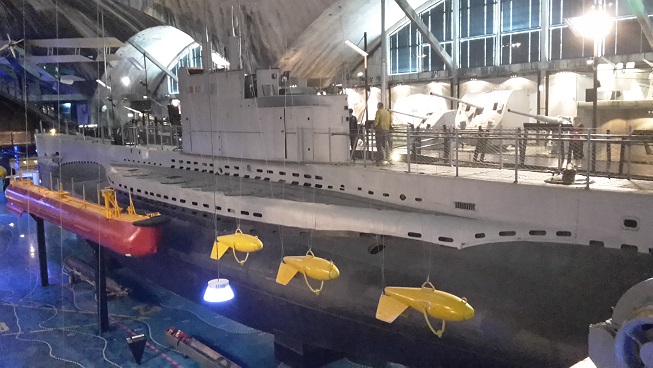
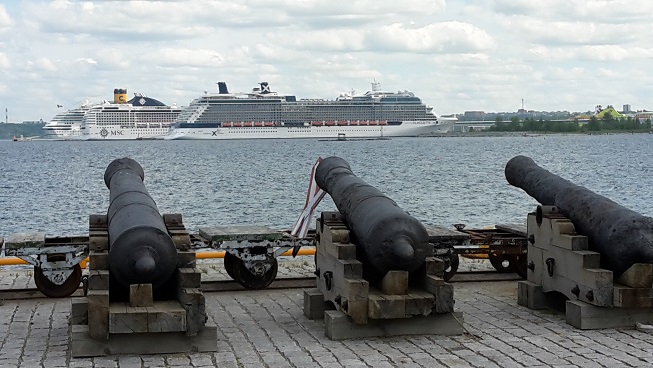
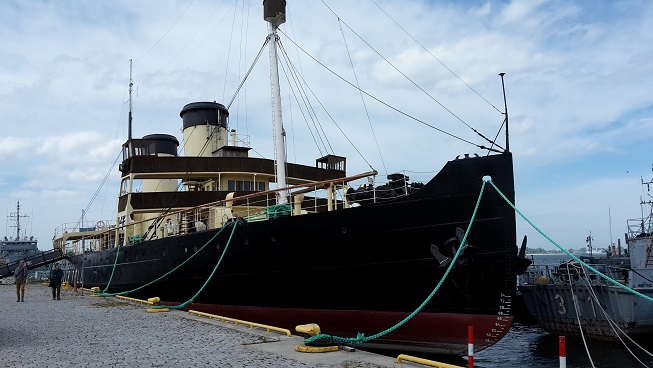
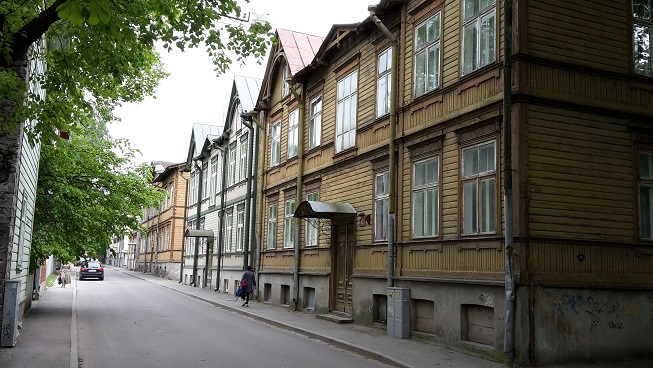

 RSS Feed
RSS Feed